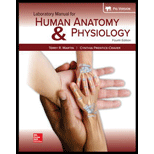
Concept explainers
Which of the following is not a function of connective tissues?
- fill spaces
- provide support
- bind structures together
- body movement
Introduction :
The connective tissue is abundantly distributed in the body. The fibers, ground substance, and cells together constitute the connective tissue. The extracellular matrix consists of fibers and ground substance. The major components of connective tissue vary from one organ to another organ. The connective tissue is divided into specialized and soft connective tissue. The connective tissue function is to provide insulation, protection, binding, storage of reserve fuel and transporting substances.
Answer to Problem 1PL
Correct answer :
The correct answer is option (d) body movement.
Explanation of Solution
Explanation/justification for the correct answer :
Option (d) body movements. The connective tissue provides support, fills spaces and binds the structure together. The muscle tissue is involved in body movements. The stimulus allows muscle tissue to contract and allow body movement. So, the correct answer is an option (d).
Explanation for incorrect answer :
Option (a) fills spaces. The space between different tissues and organs is filled with connective tissue. The space between fibers of the muscle, around lymph and blood vessels, are filled with connective tissue. This filled space provides metabolic and structural support to various organs and tissues. The connective tissue is divided into specialized and soft connective tissue.
Option (b) provides support. The framework and support for the body are provided by connective tissue. For example- cartilage and bone, both provide strength and support to the body. So, this is an incorrect answer.
Option (c) binds structures together. The connective tissue binds the structure together. For example- loose connective tissue connects epithelial tissue to underlying tissues. The connective tissue also holds organs at their place. So, this is an incorrect option.
Want to see more full solutions like this?
Chapter 9 Solutions
Laboratory Manual For Human Anatomy & Physiology
Additional Science Textbook Solutions
Biological Science (6th Edition)
HUMAN ANATOMY
Campbell Essential Biology (7th Edition)
Genetics: From Genes to Genomes
Biology: Life on Earth with Physiology (11th Edition)
- 18. Watch this short youtube video about SARS CoV-2 replication. SARS-CoV-2 Life Cycle (Summer 2020) - YouTube.19. What is the name of the receptor that SARS CoV-2 uses to enter cells? Which human cells express this receptor? 20. Name a few of the proteins that the SARS CoV-2 mRNA codes for. 21. What is the role of the golgi apparatus related to SARS CoV-2arrow_forwardState the five functions of Globular Proteins, and give an example of a protein for each function.arrow_forwardDiagram of check cell under low power and high powerarrow_forward
- a couple in which the father has the a blood type and the mother has the o blood type produce an offspring with the o blood type, how does this happen? how could two functionally O parents produce an offspring that has the a blood type?arrow_forwardWhat is the opening indicated by the pointer? (leaf x.s.) stomate guard cell lenticel intercellular space none of thesearrow_forwardIdentify the indicated tissue? (stem x.s.) parenchyma collenchyma sclerenchyma ○ xylem ○ phloem none of thesearrow_forward
- Where did this structure originate from? (Salix branch root) epidermis cortex endodermis pericycle vascular cylinderarrow_forwardIdentify the indicated tissue. (Tilia stem x.s.) parenchyma collenchyma sclerenchyma xylem phloem none of thesearrow_forwardIdentify the indicated structure. (Cucurbita stem l.s.) pit lenticel stomate tendril none of thesearrow_forward
- Identify the specific cell? (Zebrina leaf peel) vessel element sieve element companion cell tracheid guard cell subsidiary cell none of thesearrow_forwardWhat type of cells flank the opening on either side? (leaf x.s.) vessel elements sieve elements companion cells tracheids guard cells none of thesearrow_forwardWhat specific cell is indicated. (Cucurbita stem I.s.) vessel element sieve element O companion cell tracheid guard cell none of thesearrow_forward
 Human Physiology: From Cells to Systems (MindTap ...BiologyISBN:9781285866932Author:Lauralee SherwoodPublisher:Cengage Learning
Human Physiology: From Cells to Systems (MindTap ...BiologyISBN:9781285866932Author:Lauralee SherwoodPublisher:Cengage Learning Human Biology (MindTap Course List)BiologyISBN:9781305112100Author:Cecie Starr, Beverly McMillanPublisher:Cengage Learning
Human Biology (MindTap Course List)BiologyISBN:9781305112100Author:Cecie Starr, Beverly McMillanPublisher:Cengage Learning Biology: The Unity and Diversity of Life (MindTap...BiologyISBN:9781305073951Author:Cecie Starr, Ralph Taggart, Christine Evers, Lisa StarrPublisher:Cengage Learning
Biology: The Unity and Diversity of Life (MindTap...BiologyISBN:9781305073951Author:Cecie Starr, Ralph Taggart, Christine Evers, Lisa StarrPublisher:Cengage Learning
 Biology 2eBiologyISBN:9781947172517Author:Matthew Douglas, Jung Choi, Mary Ann ClarkPublisher:OpenStax
Biology 2eBiologyISBN:9781947172517Author:Matthew Douglas, Jung Choi, Mary Ann ClarkPublisher:OpenStax





